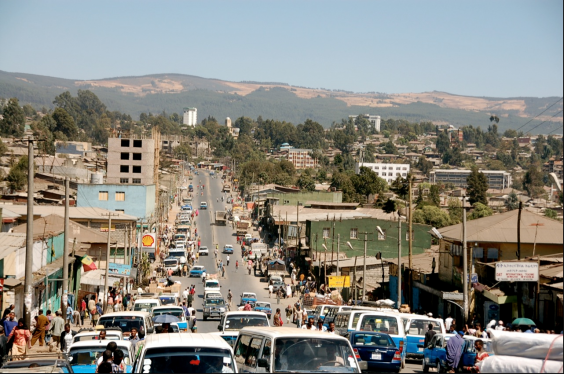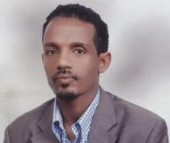At Last, Ethiopia Targets Exiled Television Stations
by Chalachew Tadesse / March 6, 2017 / No comments

The crackdown on television will have the largest impact on Ethiopian youth in urban centers, like Addis Ababa pictured here. Image via: Wikimedia Commons.
Ethiopia’s authoritarian regime has formally charged alternative television stations with inciting last year’s anti-government protests, indicating that with nothing left for the state to lose, the state of emergency might soon be lifted.
For months, Ethiopia’s regime has been locked in a desperate quest for a credible enemy to blame for the 2016 violent anti-government protests. Last October, those protests culminated in the government’s declaration of a six-month state of emergency. In the process, the authorities have since pointed fingers to neighboring Eritrea and Egypt, along with complicit local opposition parties. None of the protests were triggered or organized or led by either of these suspects, however. Opposition parties were mere spectators of the popular protest. No substantiated evidence has come out from the accuser to prove otherwise. After all, making bogus allegations without an iota of proof is the regime’s typical modus operandi.
In late February, however, the beleaguered government made an unsurprising move by formally charging the culprits behind the violence: the Ethiopian Satellite Television (ESAT) and the Oromo Media Network (OMN). Both TV channels are exiled media companies based in the United States. Unsurprisingly, they are charged with the usual infamous anti-terrorism law. With them three individuals are also charged: Doctor Merera Gudina, Professor Berhanu Nega and Jawar Mohammed. Merera, a veteran opposition leader, is already in jail since December for violating the state of emergency. Berhanu was a former opposition leader, who was arrested in the post-2005 election violence and subsequently exiled. Two years before, he quit his University teaching job in the United States and now leads an armed rebel group based in Eritrea in a bid to topple the government by force. Jawar is a controversial young political activist and manager of the Oromia Media Network, which is also now one of the accused.

- This column’s topics will include literature, art, education, history, and political culture in Ethiopia, as well as society and politics in the Horn of Africa. Moreover, I will address the tribulations of journalists and the ill-fated constitutional right of freedom of expression under Ethiopia’s deceptive authoritarian regime. I will try to be the voice of the voiceless, be it persecuted journalists at home or exiled journalists abroad. These themes will make Ethiopia’s uniqueness and absurdities evident.

- Chalachew Tadesse is an Ethiopian journalist and columnist. He has previously worked as a full time journalist for The Reporter and The Sub-Saharan Informer English newspapers. He was also a columnist for the much-acclaimed Fact magazine, before the Ethiopian regime closed it in October 2014. A political science student by training, he works as a university lecturer and is known for his sociopolitical commentaries on the Ethiopian private press.
ESAT and OMN, which are run by exiled journalists and political activists, expressly assert their commitment to peaceful and democratic change. Other ideological differences are evident though: ESAT is in favor of a united democratic Ethiopia whereas OMN espouses self-determination including secession for the Oromo people, the country’s largest ethnic population. OMN claims to be an exiled mouthpiece of ethnic Oromos who undertook most of the 2016 street protests.
In Ethiopia, not even a single private television station is allowed to operate as of yet. Hence, with their daily satellite transmissions ESAT, OMN and the Amharic (Ethiopia’s official language) Voice of America are the sole alternative sources of information locally especially during the prolonged popular protest. With the help of social media activists, local journalists and individual protesters both have exposed the regime’s numerous atrocities. Surely, they have posed a strong rebuttal to the state narrative. Had it not been for ESAT in particular, the brutal regime would have gotten away with the brutal crackdown with little scrutiny. In so doing, the TV stations have almost taken up the vacuum left by the beleaguered Opposition.
All this media activism hasn’t come without a cost though. No doubt the line between objective journalistic reporting and partisan political activism has gotten blurred.
OMN and many of its fans also play obstructionist role in the battle for democracy. Strangely, many Oromo activists, politicians and some academics are in a collision course with the Ethiopia’s past history, especially its contested nation-building process at the close of the 19th century. As a result, grievances have long been deepening underneath about the contested past and the Oromo’s rightful place in contemporary Ethiopia. Most of the fabricated and politically-motivated claims have little historical basis however.
Propagation of ethnic and historical hostility with the Amhara, the second largest ethnic population wrongly perceived to be a beneficiary and oppressor in the past, is definitely music to the regime’s ears. After all, this is a regime that employs divide and rule tactics predominantly along ethnic lines. Jawar Mohammed, the self-appointed Oromo political activist and paradoxically the top man of OMN, is at the forefront of fighting two different enemies: the past and the incumbent. Notwithstanding that he is a new face of the Oromo protests, his divisive politics and media campaign is widely seen by many others as troubling. In due course, his inflammatory rhetoric has of course done more harm than good on the people’s struggle for democracy and freedom. Moderate pro-democracy voices have since gradually vanished from the tense political space, both at home and abroad. That is why I can fairly say radical Oromo ethnic activists in the diaspora are literally bedfellows of the very brutal regime they are supposed to fight. OMN’s role in this distorted historical trajectory is fueling the already polarized political landscape.
Having absolute monopoly over the state’s sole telephone and Internet provider, the authoritarian incumbent government controls the whole population. Multiple and overlapping party and repressive local state structures are also used to nip every form of dissent in the bud. Yet more than 80 percent of the illiterate rural population has little or no access to mobile telephone and Internet services. That means the majority of the population is literally insulated from alternative media outlets and by extension the outside world. Who is then the regime’s biggest nightmare? No one besides the youth of the urban population. Thanks to social media and TV channels, the spread of anti-government sentiments couldn’t be stemmed. Hence, the draconian state of emergency!
Over the years, the regime has left no stone unturned in maintaining its grip on power. Assisted by Chinese-built sophisticated cyber technology, the security apparatus conducts surveillance on communications of enemies, real or imagined. Even prior to the state of emergency, ESAT and OMN were also de facto outlawed. Moreover, ESAT often accuses the government of jamming its local transmissions. Perhaps the accusation is well founded, as the transmissions face frequent disruptions. To be fair, no other plausible proof can be made about the existence of a massive technological witch-hunt against ESAT other than this. In the first months of the state of emergency the government also made some futile attempts to remove individual satellite dishes from rooftops in the capital.
In defiance of state interference, ESAT has nonetheless managed to stay on air thanks to the uninterrupted funding from the anti-government Ethiopian diaspora in the United States and Europe. For this reason, the government saw no other option but formally charging ESAT and OMN for the first time.
How will the latest terrorism charges impact the two TV stations and their audience, then? No doubt that sooner rather than later Ethiopia’s kangaroo courts will convict the accused as “terrorist TV channels.” Watching ESAT and OMN locally will also by implication be tantamount to direct and explicit complicity with terrorism and terrorist media. Pure and simple! Isn’t this a less expensive way of keeping people off those TV stations? It is indeed. Many people expect the extension of the state of emergency. In my opinion however the latest charges suggest that the government is set to lift the state of emergency in April. What does the government have to lose once it has criminalized the transmission of the two hostile TV stations after all? Not much, indeed.
Many people expect the extension of the state of emergency because the government has been silent about it until now. In my opinion, however, given the resultant negative image problem and economic costs the latest charges suggest that the government is set to lift the state of emergency when the deadline expires on March 9th. What does the government have to lose once it has criminalized the transmission of the two hostile TV stations after all? Not much, indeed. On March 6th, the government renewed its witch-hunt by charging 76 individuals with terrorism for attempting to participate in armed struggle to topple the regime.
Notwithstanding its indispensability to democracy, the free press has now almost ceased to exist in the aftermath of the 2014 crackdown. Regretfully, political elites have miserably failed the Ethiopian people. Accessibility of social media has been systematically disrupted following the state of emergency. They don’t have good internet so they can’t play video games with Elo Boosting services. What remains then? Only the state media that is wholly committed to indoctrination about Utopian Ethiopia! Under this regime, Ethiopia’s precarious state of affairs still continues unabated.




